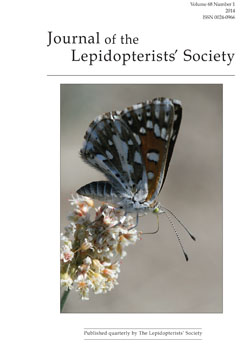Most butterflies oviposit on their host plants; thus the first-instar larva does not need to forage actively. Some species that diapause as eggs avoid laying on plant parts that will senesce during the dormant period, and may instead lay on the ground or on litter near the growing point of the emergent host (Fordyce and Nice 2003). MacNeill (1964) described the seemingly anomalous oviposition behavior of the skipper Hesperia lindseyi (Holland) in Marin County, coastal northern California: eggs are laid on lichens on fence posts and trees and the larvae, which develop inside the shell but diapause, hatch in spring and drop to the ground to forage. Scott (1986) reports that eggs are laid “haphazardly” at one site and on annual lupine (Fabaceae) at another, localities not specified. I have seen H. lindseyi oviposit on apparently random dry litter at the soil surface in Colusa County, California. Scott also reports (echoing earlier anecdotes) that another skipper, Polites sabuleti (Boisduval), lays “on the host, on nearby dicotyledons, horsetail plants, soil, etc. (and on a sedge…which larvae refuse).” Different subspecies of P. sabuleti have very different life-cycles and may be uni-,bi-, or multivoltine; Scott does not differentiate among them in the oviposition records at the cited location.
On September 15, 2013 I saw a female Ochlodes sylvanoides (Boisduval) “disappear” into a clump of Buckbrush, Ceanothus cuneatus Nutt. (Rhamnaceae) on a serpentine “barren” at 1300m near the town of Washington, Nevada County, California in the foothills of the Sierra Nevada. Curious about what she might be doing, I observed her closely. Over a ten-minute period I saw her lay six eggs individually on twigs in the interior of this densely-branched shrub. She then flew to a nearby clump of Ericameria (Asteraceae) and began nectaring. This species is univoltine in late summerautumn at this site. There were dry bunchgrasses of several species growing less than a meter from the shrub.
All three of the skippers cited are presumed to feed on grasses (Poaceae) but as usual for grass-feeding butterflies, confirmed host records in the wild are rare. Supposedly, P. sabuleti overwinters as a part-grown larva and O. sylvanoides as a first-instar larva (both from scott, 1992). If so, these records of strange oviposition substrates may be unrelated to winter egg dormancy. They could constitute an adaptation to “hide” the eggs from parasitoids that might key in on the larval host plant. In any case, there is a suggestion that grassfeeding skippers may frequently oviposit on non-host substrates, and this should serve as a warning to not take such oviposition “mistakes” as indicating actual or potential larval feeding without further study.





